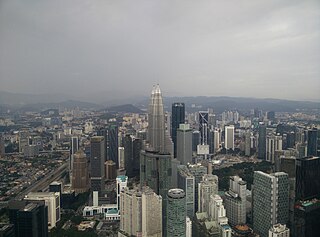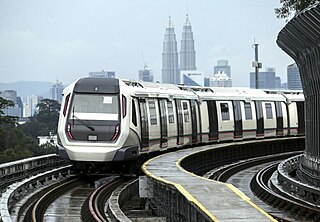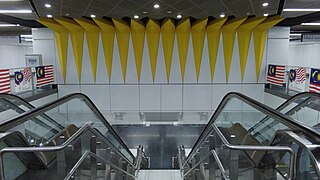
The KL Monorail Line is the only operational monorail system in Malaysia. Operated as part of the Rapid KL system by Rapid Rail, a subsidiary of Prasarana Malaysia, it is one of the components of the Klang Valley Integrated Transit System. The line is numbered 8 and coloured light green on official transit maps.

Kuala Lumpur Sentral Station is a transit-oriented development that houses the main railway station of Kuala Lumpur, the capital of Malaysia. Opened on 16 April 2001, KL Sentral replaced the old Kuala Lumpur railway station as the city's main inter-city railway station. KL Sentral is the largest railway station in Malaysia, and also in Southeast Asia from 2001 to 2021, before Krung Thep Aphiwat Central Terminal in Bangkok, Thailand was completed.

Rapid KL is a public transportation system owned by Prasarana Malaysia and operated by its subsidiaries Rapid Rail and Rapid Bus. The acronym stands for Rangkaian Pengangkutan Integrasi Deras Kuala Lumpur, which translates to Kuala Lumpur Rapid Integrated Transport Network in the Malay language. Rapid KL, with its 204.1 km (126.8 mi) of metro railway and 5.6 km (3.5 mi) of BRT carriageway, is part of the Klang Valley Integrated Transit System, operating throughout Kuala Lumpur and Selangor's satellite cities in the Klang Valley area.

Bukit Bintang is the shopping and entertainment district of Kuala Lumpur, Malaysia. It encompasses Jalan Bukit Bintang and its immediate surrounding areas. The area has long been Kuala Lumpur's most prominent retail belt that is home to many landmark shopping centres, al-fresco cafés, bars, night markets, food street, mamak stalls as well as hawker-type eateries. This area is popular among tourists and locals, especially among the youths.
Kuala Lumpur Inner Ring Road is an urban and municipal ring road system of Kuala Lumpur consisting of Jalan Sultan Ismail (Jalan Treacher), Jalan Imbi, Jalan Shaw and Federal Route 1 (Jalan Kuching, Jalan Sultan Hisamuddin (Victory Avenue), Jalan Kinabalu and Jalan Maharajalela (Jalan Birch)). Kuala Lumpur's district of shopping complexes, the Golden Triangle, is located within the ring road.
Malaysian national projects are major national projects that are important to the development of Malaysia. The following is a list from Malaysian independence in 1957 to the present.

Kuala Lumpur City Centre (KLCC) is a multipurpose development area in Kuala Lumpur, Malaysia. KLCC refers to the area within and surrounding the KLCC Park but the term has also been widely used by buildings nearby to the vicinity.
Transport in Greater Kuala Lumpur includes a road network, a railway network, airports, and other modes of public transport. Greater Kuala Lumpur is conterminous with the Klang Valley, an urban conglomeration consisting of the city of Kuala Lumpur, as well as surrounding towns and cities in the state of Selangor. The Klang Valley has the country's largest airport, the Kuala Lumpur International Airport (KLIA), as well as the country's largest intermodal transport hub and railway station, Kuala Lumpur Sentral.

Hang Tuah station, also known as BBCC - Hang Tuahstation due to the new transit hub, is an interchange station in the Pudu district of Kuala Lumpur, Malaysia, between the Ampang and Sri Petaling lines and the KL Monorail. Seamless physical and fare integration was achieved on 1 March 2012 when the "paid-up" or restricted areas of both the LRT and monorail stations, which previously operated as two separate stations, were linked up, allowing passengers to transfer without needing to buy new tickets for the first time since the monorail became operational in 2003.

The Pasar Seni station is an integrated rapid transit station in Kuala Lumpur that is served by the LRT Kelana Jaya Line and the MRT Kajang Line. The station is named after the nearby Central Market and is located near Petaling Street and the area known as the Chinatown of Kuala Lumpur.

Imbi station is a Malaysian elevated train station on the monorail line that serves as a part of the Kuala Lumpur Monorail, located in Kuala Lumpur and opened alongside the rest of the train service on 31 August 2003. The station's similar location and proximity to a shopping district as the Bukit Bintang station means that the Imbi station is also one of the most heavily used stations along the KL Monorail line.

Raja Chulan Monorail station is a Malaysian elevated monorail train station that serves as a part of the Kuala Lumpur Monorail, located in Kuala Lumpur and opened alongside the rest of the monorail service on 31 August 2003.

Medan Tuanku station is a Malaysian elevated monorail train station that serves as a part of the Kuala Lumpur Monorail, located in Kuala Lumpur and opened alongside the rest of the train service on August 31, 2003. This station was formerly called Wawasan Monorail station, since the adjacent development project was named as “Bandar Wawasan” in Kampung Baru area.

Pavilion Kuala Lumpur, also known as Pavilion KL, is a shopping centre situated in the Bukit Bintang, Bukit Jalil and Damansara Heights district in Kuala Lumpur, Malaysia.

The Klang Valley Integrated Transit System is an integrated transport network that primarily serves the area of Klang Valley and Greater Kuala Lumpur. The system commenced operations in August 1995 with the introduction of commuter rail service on the existing rail between Kuala Lumpur and Rawang. The system have since expanded and currently consists of 11 fully operating rail lines in a radial formation; two commuter rail lines, six rapid transit lines, one bus rapid transit line and two airport rail links to the Kuala Lumpur International Airport's (KLIA) Terminal 1 and Terminal 2, and one temperarily suspended airport rail link to the Sultan Abdul Aziz Shah Airport. The system encompasses 528.4 kilometres (328.3 mi) of grade-separated railway with 197 operational stations.

The Muzium Negara station is an underground mass rapid transit (MRT) station in Kuala Lumpur, Malaysia on the Kajang Line. It is located beneath Jalan Damansara in front of the Muzium Negara, which gave the station its name.

The Merdeka MRT station is a mass rapid transit (MRT) underground station in Kuala Lumpur, Malaysia. It is one of the stations of the Klang Valley Mass Rapid Transit (KVMRT) MRT Kajang Line, formerly known as Sungai Buloh–Kajang Line and serves as an interchange station with Plaza Rakyat LRT station for LRT Ampang and Sri Petaling lines. The station was opened on 17 July 2017 under Phase Two operations of the MRT line.

The Bukit Bintang MRT station, otherwise known as Pavilion Kuala Lumpur–Bukit Bintang MRT station due to sponsorship reasons, is a Mass Rapid Transit (MRT) underground station in Kuala Lumpur, Malaysia. Construction started around 2012 and opened on 17 July 2017. It served as one of the stations on the Klang Valley Mass Rapid Transit (KVMRT) Kajang Line, formerly known as Sungai Buloh–Kajang Line. The station has 5 walkways and entrances that are connected to iconic buildings and malls in the Bukit Bintang locality, including the Pavilion KL, The Starhill and Fahrenheit 88 shopping malls. The main theme of the MRT station is Dynamic Pulse of Colour.





















